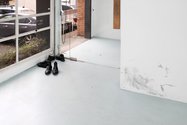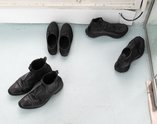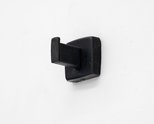John Hurrell – 4 May, 2024
Connor's method may be complex and self-referential, but it is not always about verisimilitude—though details pertaining to the particular are important. It can also be about translation, an interpretation of seen forms that revels in the sensuality of each chosen medium. It delights in the pleasures of very close scrutiny, celebrating the overt differences between displayed (often manually produced) 'coincidental' marks and 'industrial' textures, and what they might happen to represent.
Ever since she emerged as a young exhibiting Auckland artist at the end of the first decade of this century—she now lives in Los Angeles—Fiona Connor’s practice has been associated with the construction of replicas: usually of things prosaic, processual, fortuitous, unglamorous and unnoticed.
In this new Coastal Signs presentation she presents a somewhat strange exhibition title, expressing perhaps her heightened anxiety about the coming US elections, and demonstrating the interests of the above paragraph through 26 exhibits created via a variety of techniques. They can be divided up into several distinct subject-matters: a group of 3 pairs of visitors’ shoes (cast bronze), 5 groups of ‘accidental’ scuff marks on gallery walls (graphite, screenprint on vinyl), 8 interspersed coat hooks of varied form (cast bronze), random paint residues on 7 hardboard drawing boards (silkscreened), an enlarged exercise book cover (enamel paint), and 3 notebook drawings (intaglio prints). There is also a pencil drawing of a chair, fastened to a drawing board resting on that very same stackable chair.
However don’t let that last reflexive item fool you. Connor’s method may be complex and self-referential, but it is not always about verisimilitude—though details pertaining to the particular are important. It can also be about translation, an interpretation of seen forms that revels in the sensuality of each chosen medium. It delights in the pleasures of very close scrutiny, celebrating the overt differences between displayed (often manually produced) ‘coincidental’ marks and ‘industrial’ textures, and what they might happen to represent.
In this show, I think her use of screenprinting is the most salient example of her interest in humour, mundane work processes and technical intricacy. The barely detectable, subtle pitted texture of the fine mesh is something extraordinary to behold, and when on vinyl the ink takes on an ersatz ‘thickness’ to drolly represent negative gouging of the ‘violently scraped’ wall. When printed on hardboard ‘drawing boards,’ these screenprints reach yet another dimension, of refined complexity within the chaotic plethora of overlapping ‘spilt paint’ marks, and making witty references to photographed paper-holding clips and ‘stencilled’ carrying handles.
What for some might superficially be regarded as ‘runny shambolic messes,’ soon after close inspection become mentally transformed into delicate processual traces caused by seemingly wasted surplus paint, ‘residues’ left over from early applications that have accumulated in repeated layers.
In this wonderful show, another visual language, based on thinly articulated shapes fastened on to sequential outlines, is thus slowly and cumulatively articulated. Connor’s imaginative interpretations of accidental form are generated for future pondering, elaborated on materially and conceptually—and then in the viewer’s imagination, eventually explored at leisure.
John Hurrell

















 Advertising in this column
Advertising in this column Two Rooms presents a program of residencies and projects
Two Rooms presents a program of residencies and projects



This Discussion has 0 comments.
Comment
Participate
Register to Participate.
Sign in
Sign in to an existing account.